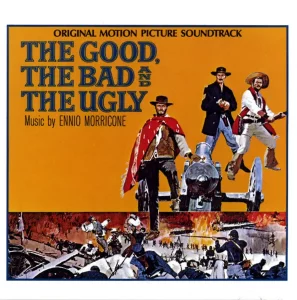Published on Aug 19, 2000
There are many movie series, but the top three in my estimation
are the
James Bond series, the
Star Wars series and the
Man With No Name series. (There are many other deserving
ones, like
Indiana Jones,
Star Trek and many others, but I think these stand above
those in terms of longevity and influence.)
I’m sure you’re all aware of the movies that made Clint “You
feelin’ lucky, punk” Eastwood into an international star. Eastwood
portrays a lone bounty hunter that roams the plains of the Old
West, dispatching a tough brand of justice to all types of outlaws
and killers. Of course, as the title suggests, his true name is
never revealed to the audience — just nicknames like Blondie or
Manco. (It was this character that Eastwood later renounced in his
Oscar-winning film, “Unforgiven.”)
In any case, a big part of Sergio Leone’s Spaghetti Westerns was
the music of composer Ennio Morricone. He provided the films with
twangy sounds and whistles that made as much sense for the
characters and setting as the Imperial March was perfect for the
Empire. Even to this day, we remember the very theme to the last
movie of that trilogy,
The Good, The Bad & The Ugly. Here we’ll take a look at
it.
What most amazed me as I heard this album is how somber and
melancholic it is. It’s like Leone wanted the music to make a
statement against the violence we see onscreen. Pieces like “The
Strong,” “The Carriage Of The Spirits,” and “The Story Of A
Soldier” are very sad and down-beat. This is due to how the main
story has the Civil War as a background. Even tracks like “Marcia”
— which feature kids whistling – and “Marcia Without Hope” —
which combines “Marcia” with “The Story Of A Soldier” to create a
cadence — do not lift one’s spirits. This is a story about dark
characters living on the fringes and the music seems to follow that
idea.
Another thing to notice is how vast several cues try to be.
Starting with “The Sundown,” which uses a wistful turn at the
guitar and violins, the music also tries to encompass the dry dunes
of the Southwestern deserts. Speaking of which, “The Desert” is
very ominous and almost has a Lawrence of Arabia vibe. The piece
follows Tuco and Blondie as they set off across the desert and it
seems to be trying to capture the beating of the harsh sun.
Of course, I must speak of the well-known title track. Famous
like the
James Bond theme and the
Mission: Impossible theme, this ranks among the very best of
Morricone’s career. It uses a male choir, some whistling and a
guitar to establish the lead characters and their world. As you
hear it, notice how it changes tone and becomes darker here or
louder there – to encapture not only Blondie, but also Angel Eyes
and Tuco.
Aside from the title track, only two other tracks do not follow
the somber and sad route — “The Ecstasy Of Gold” and “The Trio.”
Not only that, but they are also among the best tracks to be found
here. “Ecstasy” builds towards its climax using a female choir and
great orchestral work. (You might remember it from Metallica’s
S&M, where it is used to kick off the show). The final
track, “The Trio,” underscores the final duel between the three
main characters. It starts ominously with the guitar strings and
eventually brings in the rest of the orchestra to build to a final,
loud and sudden stop. Both of these tracks work great in the movie
and by themselves.
To this day, Morricone is still best known for his great scores
to the
Man With No Name trilogy. There is reason for that. The
music plays a large part in these movies in capturing all of the
plotlines, characters and places. That still doesn’t mean that it’s
for everyone. If you are a fan of fast and loud movie scores and
don’t care much for some subtlety, then you might want to avoid it.
However, if you can stand softer and somber music, you will find
that the music in this disc is great. Then, you can crank out “The
Ecstasy Of Gold” and simulate Tuco as he runs through the cemetery.
Ooh-ahh-ooh-ahh-ooh!
